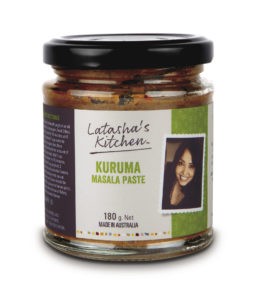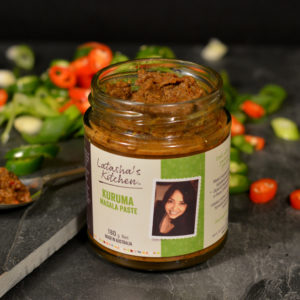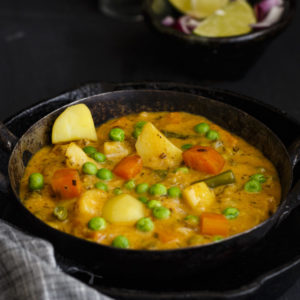KORMA MIXED VEGETABLE STEW
A hearty vegetable curry with a stew like consistency. You can also make Korma Mixed Vegetable Stew with a variety of other vegetables like eggplant, pumpkin, tomatoes or radish.
Ingredients
- Olive oil, coconut oil or ghee
- 2 whole star anise
- 3 cm cinnamon stick
- 2 bay leaves
- 2 brown onions, quartered
- 1 jar Latasha’s Kitchen Kuruma Masala Paste
- 180 ml water
- 1 x 400 g tin Mutti roma tomatoes
- 1 x 400 ml tin Ayam brand coconut cream
- 400 ml water
- ⅓ cup raisins − optional
- Bunch of coriander leaves
- ⅓ cup roasted cashew nuts − optional
- 1 tsp Latasha’s Kitchen Garam Masala Powder − optional
- Salt to taste
Vegetables to prepare
- 1 medium head of cauliflower, steam a whole head of cauli and break into florets once cooled
- 4 royal blue potatoes, boil whole, peel and quarter
- 1 medium eggpant, diced into small pieces
- 250 g French, butter or snake beans, cut into 3 cm pieces
- 2 large carrots, cut into small chunks
- 1 cup frozen green peas − corn can also be used
- 2 green chillies, split − optional
- 2 or more cups of water
Method
- Cook cauliflower and potatoes as directed above.
- Heat a casserole pot with oil. Add cinnamon stick, star anise and bay leaves. When fragrant, add onions and fry until well caramelised, at least 10 minutes on low heat.
- Next add Latasha’s Kitchen Kuruma Masala Paste and 180 ml water. Cook for 15 minutes on low to medium heat until a thick paste forms then add tinned tomatoes. Mix well and cook for another 5 minutes on medium to high heat then add eggplant, carrots, beans, peas and green chillies (if using), stir until well combined. Cook for 8 minutes on low.
- Then add cooked cauliflower and potatoes, raisins (if using), coconut cream and 400 ml water. Mix gently and add additional 2 cups water to make a smooth gravy. Add more if preferred. Cook on low heat for 10 minutes and adjust salt to taste.
- Garnish with roasted cashew nuts and coriander leaves. A sprinkle of Latasha’s Kitchen Garam Masala Powder is highly recommended.
- Enjoy with rice or Indian breads.
Tips:
- Kuruma is one of those vegetable dishes where many types of vegetables can work well. For example sometimes I use mainly tomatoes, carrots, pumpkins, sweet potatoes and green peas for a sweet tangy spicy orange coloured korma.
- I have also at times just made Korma with a mixture of long snake beans, potatoes, carrots and frozen peas. In this version I cut all three hard vegetables lengthwise instead of chunks.
- If you like potatoes, you could also make a milky, thick white creamy Korma by just using various types of potatoes with cauliflower, peas and cashew nuts.
- Another favourite way of mine when I feel like eating corn, is to use whole corn cobs, which I cut into 3 pieces with a cleaver. I make this version of Korma simply with corn cobs, peas and tinned tomatoes.
- And by the way North Indians refer to this dish as Korma while South Indians pronounce it as Kuruma. The North makes their Kormas rich with a combination of yoghurt, cream and crushed nuts like almonds while the South Indian version of Kurumas are generally lighter and spicier with the addition of coconut milk or cream, and a crushed fresh coconut masala mixture made with grated coconut flesh, cumin, back pepper, cashew nuts and green chillies.




Join #latashaskitcheners
Join Latasha's personal mailing list for delicious recipes, exclusive promotions and behind the scenes update direct to your inbox.